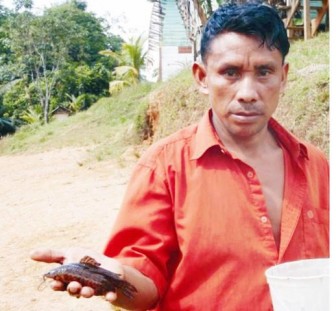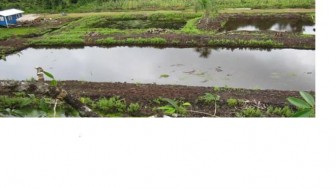There are fish in the aquaculture ponds at Tobago Hill, even though they may be difficult to see, according to the Amerindian Affairs Ministry, which yesterday accused Toshao Edmund Santiago of contributing to “misleading” reports about the project.
Stabroek News had been reporting on the status of the National Hinterland Secure Livelihood Project (NSLP) project, which was recently deemed successful by Amerindian Affairs Minister Pauline Sukhai but investigation by this newspaper proved otherwise.

Breaking weeks of silence on the state of the project, the ministry released a photograph of Toshao Santiago with a fish in hand and noted that Sukhai’s pronouncement recently on the expected harvest in a few months was based on the project officer’s monthly reports and the assurance of the aquaculture specialist.
The ministry stated that Santiago, “who is of the opinion that there are no hassar in the pond, was advised by the aquaculture specialist that indeed it is difficult to physically see the hassars as this species are bottom dwellers.” Some critics had noted that aquaculture was alien to Amerindian communities and the ministry should have focused on livelihoods which were more familiar to them.
The ministry’s release varies sharply from information provided by the Toshao during this newspaper’s visit to the small community. He said at the time that there were no fish in the four adjoining weed-filled ponds and he said that the villagers were expected to travel out of the area to catch bigger hassar to place in the ponds. The ponds also needed to be cleaned.

The ministry said on Tuesday that the specialist had corrected the “misconception” of the Toshao on the status of the project on many occasions. Santiago could not be reached for a comment on the ministry’s statement yesterday. Earlier this week, Santiago told Stabroek News that the Region One administration has committed to assist Tobago Hill to develop the fish farm. Santiago stated that the Region One Vice-Chairman and other regional officials contacted the Village Council and promised assistance. He said that Vice-Chairman Fermin Singh also indicated that the region will assist the village with fuel supplies for the journey to the Shell Beach area, where the village will source the fish.
According to the ministry’s statement, the hassar cultivation project at Tobago Hill commenced in 2010 and since then it was affected by prolonged heavy rainfall, which resulted in some delays. The preparatory works and construction of the ponds were completed in August last year, it noted, while the following month the ponds were stocked with 3,000 hassar fries.
The ministry stated that it partnered with the Voluntary Services Overseas (VSO) non-governmental organisation, which provided the aquaculture specialist who conducted capacity building and empowering sessions in fish cultivation and provided technical advice and support to the village council and local fish farmers for two years. It was noted that there was an approved extension of six months attachment by the aquaculture specialist to ensure that the beneficiaries were trained to manage the project.
This newspaper was told that the Filipino VSO left after a long frustrating wait for her contract to be renewed by the ministry, even as she indicated her willingness to continue working with Tobago Hill village council.
The ministry stated that the VSO experts were engaged to transfer technology, and train villages to acquire skills for purposes of sustainable development. “We cannot question the patience and determination of the aquaculture specialist who trained the Tobago Villagers, and who then formed a Farmers Association in the village to take care of the ponds and the fish to ensure sustainability,” it said.
According to the ministry, the success of the project lies in the village’s ownership, “and therefore, the concomitant accountability for the project.” It issued a photograph of the ponds at the start of the project without weeds.
It added that monies spent on NHSLP were not only spent in Tobago Hill and it provided a breakdown of how the monies were spent in the villages, while noting that the sums “have been well accounted and documented and are all located in the project village.”
The ministry said it has never stated that the programme is going perfectly without any hindrances and setbacks. “There are teething issues and setbacks, as you would expect from any pilot programme,” it added, noting that issues are being continuously addressed as they arise and acted upon proactively to manage risks before they occur.
In January 2012, the ministry stated, a team from the Amerindian Affairs Ministry visited all the projects under the NHSLP and consulted with stakeholders to identify strategies for overcoming current setbacks and planning for the future. It was noted that the project officer in charge of the $88M scheme is in communication with the farmers and the Community Development Officer (CDO) to monitor the projects while an international intern is currently stationed at Mabaruma to assist in such efforts.
The management and overall responsibility of projects under the NHSLP, the ministry said, lay with the local beneficiaries and the associations and the village councils, which it noted is critical to the continuous development of communities “as it creates a greater sense of ownership and participation in their own development process.”




